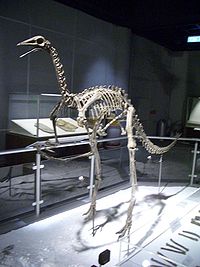Archaeornithomimus
|
Archaeornithomimus Temporal range: Late Cretaceous, 70 Ma |
|
|---|---|
 |
|
| Archaeornithomimus skeleton model displayed in Hong Kong Science Museum. | |
| Scientific classification | |
| Kingdom: | Animalia |
| Phylum: | Chordata |
| Class: | Reptilia |
| Clade: | Dinosauria |
| Order: | Saurischia |
| Suborder: | Theropoda |
| Clade: | †Ornithomimosauria |
| Family: | †Ornithomimidae |
| Genus: |
†Archaeornithomimus Russell, 1972 |
| Species | |
|
|
Archaeornithomimus (meaning "ancient bird mimic") is a genus of ornithomimosaurian theropod dinosaur from the Late Cretaceous of China, 70 million years ago.
In 1923, during the American Museum of Natural History expedition by Roy Chapman Andrews to Inner Mongolia, Peter Kaisen discovered numerous theropod remains in three quarries. These were named and shortly described by Charles Whitney Gilmore in 1933 as a new species of Ornithomimus: Ornithomimus asiaticus. The specific name refers to the Asian provenance. The species was placed in the new genus Archaeornithomimus by Dale Russell in 1972, making Archaeornithomimus asiaticus the type species of the genus. The generic name combines that of Ornithomimus with a Greek ἀρχαῖος (archaios), "ancient", because Russell mistakenly believed that the layers Archaeornithomimus was found in dated to the Cenomanian-Turonian, about 95 million years old, making it one of the oldest ornithomimids known at the time. Gilmore had not assigned a holotype specimen; in 1990 David Smith and Peter Galton in the first comprehensive description of the fossils, choose specimen AMNH 6565, a foot, as the lectotype.
The fossils were found in the Iren Dabasu Formation, which is seen as dating to the Campanian-Maastrichtian. They consist of the largely disarticulated remains of several individuals. Material of the skull and the lower jaws is lacking.
...
Wikipedia
